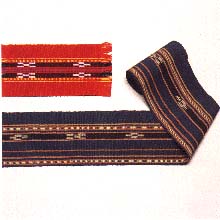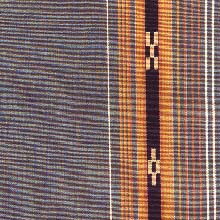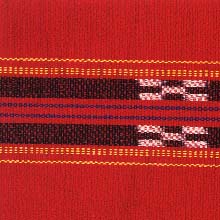Weave (p. 143 )
1. Produced in Taketomimachi(Taketomi Island) Yaeyamagun, Okinawa Prefecture.
2. Characteristics: Short width sashes, called "Minsa" with 8.5 cm width and 230 cm length. Cotton fabric of warp rib weave. On both sides of the sash, stripes are woven in which one stripes consists of a mass of short horizontal lines. It is called "Mukade(centipede) Moyo(pattern)." On another stripe between some others, the pattern of 5 and 4 square dots is woven in after one another.
3. Uses: Sashes, neckties.
4. History: The origin is not clear but "Minsa" is closely related to the act of "Kayoi Kon"(court paying) which has been practiced here until lately. When a man visited a woman at her house, the woman presented this sash to the man with an endearing heart, wishing "Itsu(whose sound means ヤfiveユ) Yo(ヤfourユ) mademo" ("Love me forever"). An allegory is expressed in the sash. In the 2 vertical stripes, a womanユs wishes are put in, requesting that the man be constant and faithful. The stripes, in which a mass of horizontal lines are woven, are called "centipede pattern" and are said to express a wish for the man to visit her frequently. Today, not only the indigo dyed "Minsa," but other multi-colored sashes, table cloths and pouches are produced.
Dyeing Method
The Minsa, which is produced in Kobama Island, near Taketomi Island, is called "Ki Ai Zome." "Ki Ai" is an Indian indigo which used to grow much in the Island. Cultivated indigo, however, is used today. The steps in "Ki(literally, tree) Ai(indigo) Zome(dyeing)" are as follows:
(1) Leaves of "Ki Ai" are put in the vat with lime water.
(2) Fermentation starts in four or five days. Skimming of the supernatant liquid. Moving the settled indigo into another vat.
(3) The indigo is again fermented. Threads are dipped and dyed here.





